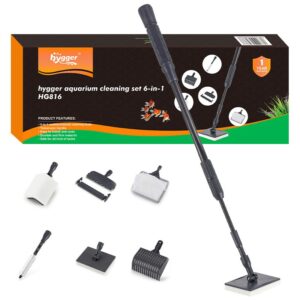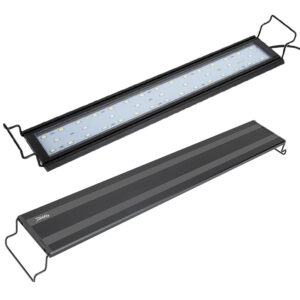Brackish water is in the middle level between freshwater and marine water. Its salinity is higher than freshwater but lower than marine water. In this article, we will explore further the brackish water fish and brackish water aquarium. After reading, you can get some maintenance tips for a brackish fish tank as well. Let’s get started.
Content Table
Brackish water aquarium
Brackish water aquariums feature salty water in the aquarium. Generally, the salinity should be maintained at about 1.005-1.012. However, the salinity levels are determined by the types of brackish water aquariums. Also, the ideal pH level should be 7.8-8.4, while the alkalinity should be at 180-360 ppm (10-20 dKH). Furthermore, brackish water aquariums are ideal to keep new aquatic species, such as Bumblebee goby, Mudskipper, and Green spotted puffer.
Are brackish aquariums hard to keep
The same as freshwater and marine aquariums, brackish water aquariums also require daily care. First of all, water change is essential. It is feasible to change 15-30 percent of the water once a week. Meanwhile, it is necessary to wash the sand in your aquarium occasionally. In this case, an aquarium cleaner can help you a lot. It can play a role in changing water but also sucking out debris and waste. Also, you need to keep the aquarium accessories clean. Thus, you should rinse the aquarium and aquarium accessories.
But do not use soap, or it will cause bad effects like foamy bubbles on the top of the tank. Besides that, you should add moderate marine salt and measure the specific gravity of the water.

Why marine salt, rather than regular aquarium salt? Marine salt contains sodium chloride and various vital minerals, such as calcium, magnesium, and potassium. While sodium chloride is the main element of regular aquarium salt. Moreover, there is also one tip for you. Do not directly add the marine salt to your brackish water aquarium, or your fish may get shocked and plants get burned. You should add the salt to a separate area, and adjust the water parameters.
After that, add the water to the brackish water aquarium until the water parameters are accepted. In addition, you need to maintain the water parameter at 76-82℉. But you can adjust according to the fish species and tank types.
What fish live in brackish water aquariums
Freshwater fish can not survive in brackish water aquariums. Not absolutely. So what fish can be kept in brackish aquariums? You will get answers from this part.
1. Guppy
Guppy fish are tropical freshwater fish, belonging to the Poeciliidae family. They are from South America. With slim bodies and attractive fins, guppies are peaceful and easy to care for. As a result, they are a great option for beginners. Moreover, guppy fish have great fertility. They can breed all year, even in winter. If you are not ready for guppy breeding, you’d better get the guppy breeding tutorial.
|
Water temperature |
72-82℉ |
 |
|
pH level |
7.0-8.0 |
|
|
Water salinity |
1.005-1.010 |
|
|
Minimum tank size |
5 gallons |
2. Molly
Molly fish are freshwater fish, which belong to the Poeciliidae family. They are native to the United States. Mollyfish possess flat bodies and short fins. Also, mollies are peaceful, which makes them a good choice for community tanks.
|
Water temperature |
75-80℉ |
 |
|
pH level |
7.5-8.5 |
|
|
Water salinity |
1.001-1.020 |
|
|
Minimum tank size |
10 gallons |
3. Mudskipper
Mudskippers are brackish water fish. And they can live in the water and the land. Mudskippers belong to the Oxudercidae family. Besides, most of them are brownish green. Furthermore, male mudskippers will grow red, green, or blue spots to attract female ones during mating seasons.
|
Water temperature |
75-85℉ |
 |
|
pH level |
7.5-8.5 |
|
|
Water salinity |
1.003-1.015 |
|
|
Minimum tank size |
30 gallon |
4. Puffer
Pufferfish can survive in brackish water aquariums, marine aquariums, and even freshwater aquariums. It depends on various puffers. Puffers belong to the Tetraodontidae family. In addition to this, puffers are aggressive, and they would nip fins.
|
Water temperature |
74-82℉ |
 |
|
pH level |
7.0-7.8 |
|
|
Water salinity |
1.005-1.018 |
|
|
Minimum tank size |
20 gallons |
5. Goby
Gobies belong to the Gobiidae family. They can be kept in freshwater and marine fish tanks, as well as brackish water fish tanks. Usually, gobies have large heads and subulate bodies. Moreover, they are often in small sizes. Gobies, like Bumblebee goby, Dragon goby, and Knight goby, are feasible to keep in a brackish water aquarium.
|
Water temperature |
75-85℉ |
 |
|
pH level |
6.5-8.5 |
|
|
Water salinity |
less than 1.010 |
|
|
Minimum tank size |
20 gallons |
Brackish aquarium tips
In this segment, we will provide some tips about brackish water aquariums. Also, it is necessary to add some aquarium equipment.
1. Tank size
Since you should not overstock, a suitable tank size is vital for fish in the aquarium. Otherwise, the waste, debris, and excess food will accumulate quickly, leading to poor water quality. It is not good for fish and other creatures in the aquarium, exactly. The tank size depends on the size and quantity of fish. 20 gallons is the recommended minimum one.
2. Aquarium heater
To keep stable water parameters, an aquarium heater is fundamental. As we have mentioned above, the water temperature in the brackish aquarium should be 76-82℉. Hence, a double quartz heater is an excellent choice. With a built-in intelligent LED digital temperature display and three temperature probes, you can check the real-time water temperature.
3. Aquarium light
Sufficient light makes brilliant fish colors. On the other hand, if there are aquatic plants in a brackish tank, java fern, anubias, and hornwort for instance. Then, adding an aquarium light would be crucial. A Bluetooth LED light is not bad for someone who wants to control lighting via a mobile phone and customized 300+ colors. And submersible LED lights are a better option for fish tanks with a hood.

4. Aquarium filter
A canister filter is an excellent option for a brackish aquarium. It can filter particles and debris effectively and also absorb odors. In the meantime, the filter can accelerate beneficial bacteria to grow.
5. Hydrometer
A hydrometer is vital in brackish aquariums, which is mainly for keeping salinity levels. With well-regulated scales, the hydrometer is easy to use, which makes the alkaline water level setting easier for beginners.
6. Fish feeder
Feeding your fish regularly and time is crucial. It is best to feed once or twice a day and make sure your fish finish eating in 2–3 minutes. An automatic fish feeder can help you take care of fish. The fish can dispense food for fish with programmable time and portion. Consequently, you do not need to worry about your fish when you are on business trips, holidays, or busy times.
Until now, we have covered some necessary aquarium equipment and maintenance tips for brackish aquariums. We believe you have known more about the brackish water aquarium, right? Assuming that you want to explore more fish tank types, why not try to set up a brackish water aquarium? Finally, thanks for your reading.


Leave a comment